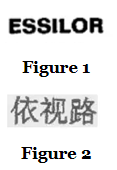Facts
In 1986 Essilor International (Compagnie Generale d'Optique) registered its trademark ESSILOR (Figure 1, Cited Mark 1) in China, designating "various spectacles and frames for protecting or correcting vision" in Class 9. In 1999 Essilor registered the trademark 依视路 (Figure 2, Cited Mark 2), the Chinese transliteration of ESSILOR, designating "spectacle lenses (non-implantable)" in Class 9.
On 4 June 2010 Shanghai Hongcheng Optical Co, Ltd filed an application to register the trademark eSSILOR依视路 (Figure 3), designating "industrial adhesives and curing agents" in Class 1.
CTMO decision
On 23 June 2011 Essilor filed an opposition with the China Trademark Office (CTMO) against Shanghai Hongcheng Optical's mark, citing its prior registrations. The CTMO dismissed the opposition on 6 November 2012, holding that:
- the goods designated by the opposed mark were different from those designated by the cited marks; and
- the evidence provided by Essilor was insufficient to prove that the opposed mark had "duplicated or copied [its] well-known trademark", as required by Article 13.2 of the Trademark Law 2001.
On 30 November 2012 Essilor filed for review with the Trademark Review and Adjudication Board (TRAB), citing Articles 13.2 (registered well-known trademark) and 31 (prior right and prior used trademark of certain influence) of the Trademark Law, among others.
TRAB decision
The TRAB held as follows:
- Article 13.2 did not apply in this case, even though Cited Mark 2 had acquired a certain reputation for spectacles. The evidence provided was insufficient to prove that the mark had acquired, through its use and promotion in mainland China, a well-known status which would justify cross-category protection.
- Article 31 also did not apply in this case. Despite the fact that Essilor had been using Cited Marks 1 and 2 as its trade name prior to the submission of the application for the opposed mark, there was a big difference between the goods designated by the opposed mark and those designated by the cited marks. Further, Essilor had failed to prove that it had used its trademark in respect of the goods designated by the opposed mark and that it had attained a certain influence in this regard.
On 14 April 2014 the TRAB approved the opposed mark's registration.
Beijing First Intermediate Court decision
Essilor appealed to the Beijing First Intermediate Court, claiming that the TRAB had failed to adjudicate on whether Cited Mark 1 had acquired well-known status.
The court ascertained that the TRAB had failed to adjudicate all of Essilor's claims, which was a breach of Article 28 of the Trademark Review and Adjudication Rules and constituted procedural violation. The court thus annulled the TRAB's decision on 30 December 2015.
Nonetheless, the trial court upheld the TRAB's findings that the evidence adduced did not prove that the cited marks had acquired well-known trademark status prior to the opposed mark's application date.
Beijing High Court decision
It was therefore necessary to appeal before the Beijing High Court, before which Essilor argued as follows:
- Cited Marks 1 and 2, which are coined terms, are highly distinctive. Both marks had acquired a reputation in the Chinese optical market and had thus become well known before the opposed mark's application date.
- The opposed mark's designated goods and those of the well-known cited marks were highly relevant. The applicant of the opposed mark, a competitor of Essilor, had exhibited bad faith in filing for the opposed mark's registration and the registration was detrimental to Essilor's legitimate rights.
Essilor adduced supplementary evidence proving that the relevant public of the opposed mark's designated goods largely overlapped with that of the cited marks' designated goods. As such, the relevant public was likely to associate the opposed mark with the cited marks and be misled, which prejudiced Essilor's interests.
The Beijing High Court ascertained that Cited Mark 2 had acquired well-known trademark status before the opposed mark's application date. Thus, on 29 November 2017 the court corrected the first-instance court's findings, while upholding its decision to rescind the TRAB's decision for its failure to address all of Essilor's claims.
For further information on this topic please contact Xingnan Ming or Wang Yan at Wanhuida Peksung by telephone (+86 10 6892 1000) or email ([email protected] or [email protected]). The Wanhuida Peksung website can be accessed at www.wanhuida.com and www.peksung.com.
This article was first published by the International Law Office, a premium online legal update service for major companies and law firms worldwide. Register for a free subscription.




